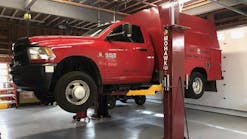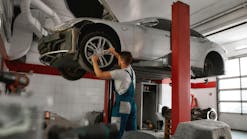It seems like everyone’s talking hybrids these days, but they’ve already been around for over ten years. With all the focus on reducing greenhouse gases and gasoline prices creeping upwards once again, hybrids seem to be the right “powertrain fashion” for more and more motorists. What does that exactly mean to you as a technician or shop owner? Read on.
Q. We’ve performed basic service on several hybrid vehicles, but we’re unsure of the volume or sophistication of repairs heading into the future. How do we plan for this?
A. It’s an excellent question and one that doesn’t have a singular answer. First, it depends on whether you’re a dealer or independent repair shop. Dealers are sure to see the initial volumes of hybrid service. As an independent shop, you have to consider whether you want to go beyond basic service and delve into system diagnosis and repair. This is a decision not to be taken lightly as safe and proper hybrid service should only be performed with the right combination of training and equipment. And, since the high-voltage electrical system of a hybrid vehicle may operate at voltages up to 650 volts, we can’t over emphasize the importance of proper safety measures during service.
Q. Our shop has decided to take the plunge and get into hybrid service, including diagnosis of the electrical hybrid drive system. What kind of equipment do we need to get started?
A. Before we address the equipment side of things, we need to stress training as the most critical first step. All procedural training for hybrid service should always be presented in the context of maximum safety due to the high voltages present. Potentially dangerous voltages exist at the high-voltage cables (usually colored bright orange), the high-voltage batteries, the inverter-rectifier capacitors, and the electric motor-generator. With that said, the minimum equipment you will need includes a CAT III or CAT IV meter rated to 1,000 volts, rubber insulating gloves and a pair of leather over-protector gloves. Rubber insulating gloves should have a Class 0 rating, meaning they have the capability of insulating the user up to a maximum of 1,000 volts. These gloves should be inspected before every use to make sure there are no pinholes capable of leaking electricity. The leather, over-protector gloves should always be worn over rubber insulating gloves to protect them from damage such as punctures and cuts from sharp edges.
Q. I’ve got an older digital multimeter that’s rated at 10 megohms input impedance. How does this specification correlate to the CAT III or CAT IV meter specifications I’ve been seeing for hybrid testing?
A. Input impedance and CAT ratings don’t correlate at all. Input impedance refers to a meter’s internal resistance, an important factor so as not to overload electronic circuits.
CAT ratings, on the other hand, refer to a standard that defines safety levels by categories for electrical meters. A meter’s CAT rating, ranging from CAT I through CAT IV, represents a meter’s capacity to withstand voltage extremes and transient voltages. Generally speaking, a CAT IV meter has better capabilities to withstand voltage extremes than a CAT I meter. Yet, there’s more to it than just the CAT ratings themselves. A CAT rating must be combined with a voltage specification to be meaningful. For example, a CAT III meter with a 1,000-volt rating is a safer meter than, say, a CAT III meter with an 800-volt rating. The bottom line is, when shopping for a meter to be used around high-voltage hybrid electrical systems, look for a meter with at least a CAT III or CAT IV/1,000 volt rating. The meter’s leads should also have the same CAT rating as the meter itself.
Q. The hybrid vehicle service training we’ve been considering covers a topic called “insulation testing.” Is this simply a physical inspection of the high-voltage cable insulation?
A. No, insulation testing is a specific diagnostic test performed using a procedure with a suitable meter having insulation testing capabilities. Put aside everything you’ve previously known about typical low-voltage insulation testing on automotive circuits; when it comes to hybrids, insulation testing takes on a whole new meaning.
Some multimeters have a dedicated insulation test function built into them and are labeled as such. Some multimeter manufacturers combine this function along with more conventional DVOM functions. When combined, this can serve as a great ally when diagnosing problems in a high-voltage hybrid circuit. The need to perform an insulation test usually comes as a pinpoint test on the heels of other diagnostic clues, such as a MIL light on the dash, trouble code, or other hybrid system warning lamp.
When performing an insulation test, you follow the manufacturer’s procedure exactly as it’s spelled out. This includes heeding the manufacturer’s safety rules and deactivating the high-voltage circuit precisely as prescribed. Again, think of these steps as being integral with the service procedure itself; follow each detail to the letter or you may be jeopardizing your safety or even your life. Generally speaking, with the meter’s leads connected as required, you apply a specified voltage with the meter to the high-voltage circuit and then read the resistance value on the meter. Typically, the voltage test value is 500 volts, again applied by the meter, and the specification for resistance will be displayed in megohms (millions of ohms). You then compare the observed reading to manufacturer’s specifications for that test. The test specification varies according to the exact test being performed.
Q. Is there any sort of online resource center where I can find more details on the availability of training, equipment and service information for hybrid vehicles?
A. Yes, the National Automotive Service Task Force on the web at www.nastf.org is a cooperative effort among the automotive service industry, the equipment and tool industry, and automotive manufacturers to ensure you have the information, training and tools needed to properly diagnose and repair today's high-tech vehicles.
One of the first projects taken on by NASTF was the OE Service Information Matrix. This is a detailed document showing what information is available directly from each car manufacturer including contact phone numbers and web sites where available. This document is continuously updated as new information and resources become available. To help identify gaps in the availability of service information, NASTF accepts feedback from you, the service professional. Any problems locating or obtaining service information through the OE Service Information Matrix may be reported directly to NASTF.
Q. Can I use a scan tool to diagnose hybrid vehicles?
A. Absolutely, just like with every conventional OBDII-equipped vehicle, a scan tool can be just as much effective when diagnosing hybrid vehicles. This includes the display of trouble codes, self-tests, freeze frame data and more. Hybrid systems often have their own trouble codes and will trip the MIL light on the dash. A fault may also trigger other lamps, indicating a problem. You’ll want to check scan tool capabilities carefully here, as your current scan tool may not be hybrid-capable, or at least not with the current scan tool software.
Just remember that the right scan tool for you depends on the exact hybrid vehicles you plan to service. The landscape of applications is changing rapidly, so check with your equipment rep to determine what options you have available. It also doesn’t hurt to ask around by checking with your fellow techs and shop owners. It just might be worth a post on the International Automotive Technicians’ Network on the web at www.iatn.net.
Q. We run a small shop and want to see how much hybrid service demand there is before we make a large investment. Do you have any business tips for this before we make the plunge?
A. To some extent, hybrid service is going to be a bit like the chicken and the egg metaphor. If you don’t actively seek motorists with hybrid cars, then it might not appear as though there’s ample reason to make the investment. No matter how you go about making that rationale, just remember that there are a lot of other service opportunities on hybrid vehicles that have nothing to do with the high-tech hybrid drive system. For instance, some hybrids still require periodic valve adjustments on their ICE (Internal Combustion Engine) part of the drive system, and there are still normal wear-and-tear items like brakes and tires.
There’s little doubt that hybrid technology will continue to complement vehicle platforms, just the same as other technologies have in the past. By staying both informed and aware, you’ll be in the driver’s seat to make the right choices for you and your shop—and PTEN will be there to help guide you on your way.

